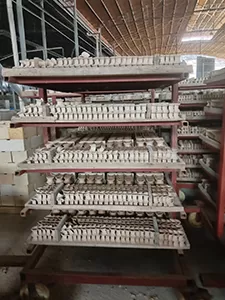Intalox saddle packing stands out in industrial separation processes due to its unique structural design and versatile performance, combining advantages of both random packings and structured elements. Its characteristics vary slightly by material (ceramic, metal, plastic) but share core traits that enhance mass transfer efficiency, operational stability, and adaptability to diverse conditions.

Structural Advantages
The signature saddle-shaped design eliminates "dead zones" common in traditional ring packings, promoting uniform gas-liquid distribution. Its curved profile and open geometry create tortuous flow paths that increase interfacial contact time between phases, while avoiding excessive resistance. Compared to pall rings, the saddle structure reduces wall flow and channeling, ensuring more consistent packing density during installation. For ceramic and metal variants, integrated reinforcing ribs or tabs enhance mechanical strength without sacrificing void space, balancing structural stability with fluid permeability.
Mass Transfer Efficiency
Intalox saddles deliver high mass transfer rates due to their optimized specific surface area and void fraction. Smaller sizes (16mm–25mm) offer large specific surface areas (200–300 m²/m³), maximizing contact between gases and liquids—ideal for high-purity distillation or fine chemical separation. Larger sizes (50mm–76mm) maintain sufficient surface area (50–100 m²/m³) while increasing void fraction (≥0.85), reducing pressure drop and making them suitable for high-flux applications like gas absorption. The design minimizes liquid hold-up, accelerating mass transfer kinetics and improving process efficiency across varying load ranges (30%–120% of design capacity).
Material-Specific Performance Traits
- Ceramic saddles: Excel in corrosion resistance, withstanding acids, alkalis, and organic solvents, making them suitable for harsh environments like sulfuric acid processing. They exhibit high-temperature stability (up to 1200°C) but are brittle and require careful handling to avoid breakage.
- Metal saddles: Offer superior mechanical strength and temperature tolerance (-200°C to 600°C), ideal for high-pressure petroleum distillation or hydrogenation processes. Stainless steel and nickel alloy variants enhance corrosion resistance, though they are less cost-effective than carbon steel for non-corrosive applications.
- Plastic saddles: Provide lightweight convenience and cost-effectiveness, with good chemical resistance in low-temperature (≤120°C) scenarios such as water treatment or food-grade separation. Materials like PVDF extend their use to mild oxidizing environments, though they lack the high-temperature durability of metal or ceramic.
Operational Stability
The packing maintains stable performance across fluctuating process conditions. Its symmetric shape ensures uniform loading, reducing the risk of flooding or weeping even at varying flow rates. For ceramic and metal types, resistance to thermal shock (ceramic) or deformation (metal) allows reliable operation in temperature-cycling environments, such as batch distillation processes. Plastic variants, while less heat-resistant, offer flexibility in low-pressure systems and easy installation due to their lightweight nature. All materials resist fouling better than structured packings, with self-cleaning properties in turbulent flow conditions.
Cost and Maintenance Benefits
Intalox saddles balance performance with economic efficiency. Plastic variants have the lowest upfront cost and simplify installation, suitable for budget-sensitive or short-term projects. Ceramic options offer long service life (5–10 years) in corrosive environments, minimizing replacement frequency. Metal saddles, though higher in initial investment, reduce downtime due to their durability in high-load operations, justifying costs in large-scale industrial plants. Maintenance requirements are minimal—periodic cleaning (for fouling-prone applications) and visual inspections suffice, with no complex disassembly needed compared to structured packing systems.

